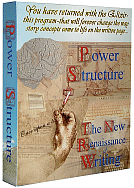|
|


TechnoFILE is copyright and a registered trademark © ® of
Pandemonium Productions.
All rights reserved.
E-mail us Here!

Plugging the Black Holes in Your Creative Writingby Jim Bray Writers planning the Great American Novel, or screenplay, but who have no idea where to begin, have a powerful new ally at their fingertips. Power Structure may just be manna from Heaven for writers frustrated by trying to keep track of who did what to whom, and when and where they did it. It's a wonderful software tool that lets you organize your people, places and things before and during the actual process of churning out the prose. From the makers of Movie Magic Screenwriter 2000, Power Structure is designed as kind of a project management tool, with word processing capabilities built in to boot. The goal is to help you make your epic as airtight as possible before sending it off to be torn apart by some heartless editor perched in an ivory tower somewhere. I wish I'd had such a tool when I wrote my first novel. Perhaps it wouldn't be gathering dust on my zip disk backup to this day. Then again, maybe it just stank…. Anyway, Power Structure ($199 for Windows) isn't designed to tell you what or how to write. Instead, it's more like a set of virtual crib notes you create yourself, in whatever level of detail you choose, so it not only helps you organize and track, it gives you writing practice while forcing you to think about some critical questions that need to be answered if your story's to be believable. It's also an "idea clearinghouse" you can use to store and organize story ideas and situations you may want to use down the road, but don't have a story for just yet. This is a wonderful thing on its own: it can help you clear from your office all those little bits of paper and notepads on which you've been jotting down notes and ideas. If I had software like this for everything I do, I might be able to see my real desktop periodically! The easiest way to get up to speed with Power Structure is to use one of the built in templates, which cover novel, play, screen or TV writing. There's also a nifty start up lesson that, in conjunction with the innovatively-laid out manual, helps you get up to speed with the program and its raison d'etre. It tells the timeless tale of Jill, the woman who goes up the hill with the man she loves, but falls to her tragic death. That's the premise of the story, but your Jack and Jill tale won't sell if you leave it at that. So Power Structure prompts you to think about other aspects of the story. Who is Jill? What makes her tick? How about Jack? Each of a series of screens represents a particular aspect of the story creation process and by completing each of these (or as many as you choose to complete), you work out the details of your story before you actually commit them to electrons. Power Structure gives you places to store your thoughts about each major and minor character, including physical appearance, desires, strengths, faults, etc. You can also create a "backstory" (to help you set the stage for your main story) or write a synopsis. You can also structure your story by acts, chapters, or plot points, and the software offers up spots with which to keep track of the plot from your initial hook through all the other plot points you create yourself, right to the exciting climax. This means that, at least theoretically, you enter the writing process less likely to run into unexpected hitches or holes that might otherwise cause you to stop writing and start poring madly through your already-completed work, trying to find a logical solution with which to bail your characters out of their author-created conundrums. I haven't gone through the process enough yet to have completed an original story, but I'm now using Power Structure to plan my second novel. Before Power Structure, I'd been turning over ideas in my head for months and, when I bothered to write anything down, I could never find it afterward. Now I'm electronically scribbling thoughts into Power Structure and the benefits are already showing up in an exhilarating sense of organization and control that I never had before. Who knows, maybe this novel will sell! Jim Bray's technology columns are distributed by the TechnoFILE and Mochila Syndicates. Copyright Jim Bray.
|
|
|
|
|
| Support TechnoFile via Paypal |
| TechnoFILE's
E-letter We're pleased to offer our FREE private, subscription-based private E-mail service. It's the "no brainer" way to keep informed. Our Privacy Policy |